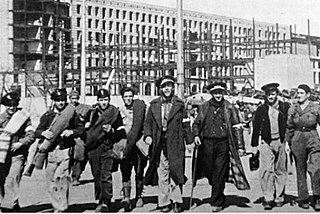
José Miaja Menant was a General of the Second Spanish Republic.

The 223rd Mixed Brigade, was a mixed brigade of the Spanish Republican Army in the Spanish Civil War. It was formed in the summer of 1937 from Coastal Defence units and had four battalions, the 889, 890, 891 and 892. This unit lasted until the end of the war.

The Central Region Army Group, Spanish: Grupo de Ejércitos de la Región Central (GERC), was a military formation of the Spanish Republican Army during the last phase of the Spanish Civil War. It gathered the most powerful section of the republican military and would endure until the 1939 surrender. The GERC was under the command of general José Miaja Menant, the Defence of Madrid hero.

The Eastern Region Army Group, Spanish: Grupo de Ejércitos de la Región Oriental (GERO), was a military formation of the Spanish Republican Army during the last phase of the Spanish Civil War. It was established in June 1938 as a response to the splitting in two of the territory under the sovereignty of the Spanish Republic after the Central Region Army Group (GERC), under the command of General Miaja, had been set up in the central-southern region of Spain.

The National Defence Council was the governing body in Republican Spain at the end of the Spanish Civil War (1936–1939). The council seized power with Colonel Segismundo Casado's coup on 5 March 1939 when it was clear that the Republicans had lost the war. The leaders hoped to negotiate an end to hostilities with the rebel forces led by General Francisco Franco. However, Franco insisted on unconditional surrender, and on 26 March 1939 launched the final offensive of the Spanish Civil War. By the end of the month he controlled the whole country. Most of the council members escaped into exile on British warships.

The 1st Division was a division of the Spanish Republican Army in the Spanish Civil War.

Ángel Bahamonde Magro is a Spanish historian. He is professor of Contemporary History at the Charles III University of Madrid (UC3M).
The 83rd Mixed Brigade was a unit of the Spanish Republican Army created during the Spanish Civil War from the militarization of the Iron Column. It came to operate on the Teruel, Levante and Central fronts.
The 70th Mixed Brigade was a unit of the Spanish Republican Army created during the Spanish Civil War. The unit intervened in the battles of Jarama, Guadalajara and Brunete. At the end of the war it played a role in the Casado coup.
The 59th Mixed Brigade was a unit of the Spanish Republican Army created during the Spanish Civil War. It came to operate on the Teruel and Ebro fronts.
The 14th Division was one of the divisions of the Spanish Republican Army that were organized during the Spanish Civil War on the basis of the Mixed Brigades. The division participated in the Battle of Guadalajara.
Eusebio Sanz Asensio was a Spanish anarchist and military commander.
Feliciano Benito Anaya was a Spanish anarcho-syndicalist.
The 98th Mixed Brigade was a unit of the People's Army of the Republic created during the Spanish Civil War. Throughout the war it came to operate on the Madrid, Guadalajara and Levante fronts.
Rafael Gutiérrez Caro was an Andalusian anarchist militant.
José Luzón Morales was a Spanish anarchist militant who was part of the "Spartacus" battalion in the Spanish Civil War.
The 33rd Division was one of the divisions of the Spanish Republican Army that were organized during the Spanish Civil War on the basis of the Mixed Brigades. It was deployed on the Aragon and Guadalajara fronts.
The 71st Mixed Brigade was a unit of the Spanish Republican Army that participated in the Spanish Civil War, deployed on the Guadalajara front.

Enrique Jurado Barrio was a Spanish military colonel who fought in the Spanish Civil War for the Second Spanish Republic. Born in a family with a strong military background, Jurado participated in the war in Morocco, and on war merits he was promoted despite his opposition to this type of promotion.

Spanish coup of March 1939, in historiography often referred to as Casado's coup, was a coup d'état organized in the Republican zone against the government of Juan Negrín. It was carried out by the military with support of the Anarchists and the Socialists; its leader was commander of the Army of the Centre, Segismundo Casado. The conspirators viewed the Negrín government as a hardly veiled Communist dictatorship. Most concluded that the government-endorsed strategy of unyielding resistance against the Nationalists would produce nothing but further deaths and sufferings while the war had already been lost. The military and some politicians intended the coup as a first step towards opening peace negotiations with the Nationalists; for the Anarchists and Socialists the priority was to remove the Communists from power.






